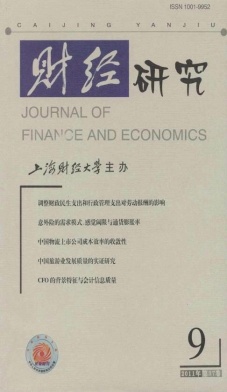财政政策对私人消费非线性效应的存在性及触发条件研究
财经研究 2011 年 第 37 卷第 09 期, 页码:17 - 28
摘要
参考文献
摘要
文章通过构建财政政策与私人消费关系的理论模型,初步证明了财政政策对私人消费可能存在的非线性效应以及财政政策究竟发挥何种效应是由触发条件内生决定的事实。在此基础上文章运用门限模型,将触发条件量化为门限指示变量,并以1993年1月至2009年11月的月度数据为样本对上述问题进行了实证研究。结果发现:(1)在样本期内,财政支出政策对私人消费总体上表现为凯恩斯效应,与此相对的是税收政策表现为显著的非线性效应,并以税收增长率0.287为临界值,财政政策从凯恩斯区制向非凯恩斯区制转移;(2)我国财政政策非凯恩斯区制与高通胀区制高度吻合,即在经济出现高通胀的情况下,财政政策可能引发非凯恩斯效应;(3)我国财政政策对私人消费的促进作用十分有限,乘数效应并不明显。故政府应对财政政策做出适当的调整,在积极解决当前高通胀问题的同时,确保私人消费有效增长。
[1]方红生,郭林.中国财政政策对居民消费的非线性效应:理论和实证[J].经济问题,2010,(9):10-14.
[2]郭庆旺,贾俊雪.稳健财政政策的非凯恩斯效应及其可持续性[J],中国社会科学,2006,(5):58-67.
[3]郭庆旺,贾俊雪,刘晓路.财政政策与宏观经济稳定:情势转变视角[J],管理世界,2007,(5):7-15.
[4]李永友.财政政策的凯恩斯效应与非凯恩斯效应[J],上海财经大学学报,2008,(2):63-70.
[5]王立勇,高伟.财政政策对私人消费非线性效应及其解释[J],世界经济,2009,(9):27-36.
[6]Afonso A.Non-Keynesian effects of fiscal policy in the EU-15[R].ISEG Working Pa-per,2001:1-47.
[7]Alesina A,Perotti R,Tavares J.The political economy of fiscal adjust ments[J].Brook-ings Papers on Economic Activity,1998,(1):197-266.
[8]Bertola G,Drazen A.Trigger points and budget cuts:Explaining the effects of fiscalausterity[J].American Economic Review,1993,83(1):11-26.
[9]Cour P,Dubois E,Mahfouz S,et al.The cost of fiscal retrenchment revisited:Howstrong is the evidence[J].Economic International,1996,68:7-28.
[10]H ppner F,Wesche K.Non-linear effects of fiscal policy in Germany:A Markov-switching approach[R].Discussion Paper,University of Bonn,2000.
[11]Gali J,López-Salido D,Vallés J.Understanding the effects of government spending onconsumption[J].Journal of the European Economic Association,2007,5(1):227-270.
[12]Giavazzi F,Pagano M.Can severe fiscal contractions be expansionary?Tales of twosmall European countries[J].NBER Macroeconomics Annual,1990:75-122.
[13]Ganellig,Tervala J.Can government spending increase private consumption?The roleof complementarity[J].Economics Letters,2009,103:5-7.
[14]Linnemann L.The effect of government spending on private consumption:A puzzle?[J].Journal of Money,Credit and Banking,2006,38:1715-1735.
[15]Horvath M.The effects of government spending shocks on consumption under opti malstabilization[J].European Economic Review,2009,53:815-829.
[16]Sutherland A.Fiscal crises and aggregate demand:Can high public debt reverse theeffects of fiscal policy?[J].Journal of Public Economics,1997,65:147-162.
[2]郭庆旺,贾俊雪.稳健财政政策的非凯恩斯效应及其可持续性[J],中国社会科学,2006,(5):58-67.
[3]郭庆旺,贾俊雪,刘晓路.财政政策与宏观经济稳定:情势转变视角[J],管理世界,2007,(5):7-15.
[4]李永友.财政政策的凯恩斯效应与非凯恩斯效应[J],上海财经大学学报,2008,(2):63-70.
[5]王立勇,高伟.财政政策对私人消费非线性效应及其解释[J],世界经济,2009,(9):27-36.
[6]Afonso A.Non-Keynesian effects of fiscal policy in the EU-15[R].ISEG Working Pa-per,2001:1-47.
[7]Alesina A,Perotti R,Tavares J.The political economy of fiscal adjust ments[J].Brook-ings Papers on Economic Activity,1998,(1):197-266.
[8]Bertola G,Drazen A.Trigger points and budget cuts:Explaining the effects of fiscalausterity[J].American Economic Review,1993,83(1):11-26.
[9]Cour P,Dubois E,Mahfouz S,et al.The cost of fiscal retrenchment revisited:Howstrong is the evidence[J].Economic International,1996,68:7-28.
[10]H ppner F,Wesche K.Non-linear effects of fiscal policy in Germany:A Markov-switching approach[R].Discussion Paper,University of Bonn,2000.
[11]Gali J,López-Salido D,Vallés J.Understanding the effects of government spending onconsumption[J].Journal of the European Economic Association,2007,5(1):227-270.
[12]Giavazzi F,Pagano M.Can severe fiscal contractions be expansionary?Tales of twosmall European countries[J].NBER Macroeconomics Annual,1990:75-122.
[13]Ganellig,Tervala J.Can government spending increase private consumption?The roleof complementarity[J].Economics Letters,2009,103:5-7.
[14]Linnemann L.The effect of government spending on private consumption:A puzzle?[J].Journal of Money,Credit and Banking,2006,38:1715-1735.
[15]Horvath M.The effects of government spending shocks on consumption under opti malstabilization[J].European Economic Review,2009,53:815-829.
[16]Sutherland A.Fiscal crises and aggregate demand:Can high public debt reverse theeffects of fiscal policy?[J].Journal of Public Economics,1997,65:147-162.
引用本文
项后军, 周宇. 财政政策对私人消费非线性效应的存在性及触发条件研究[J]. 财经研究, 2011, 37(9): 17–28.
导出参考文献,格式为:





 5903
5903  3101
3101

